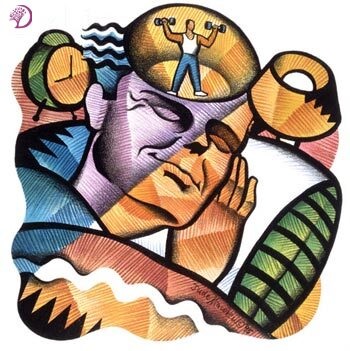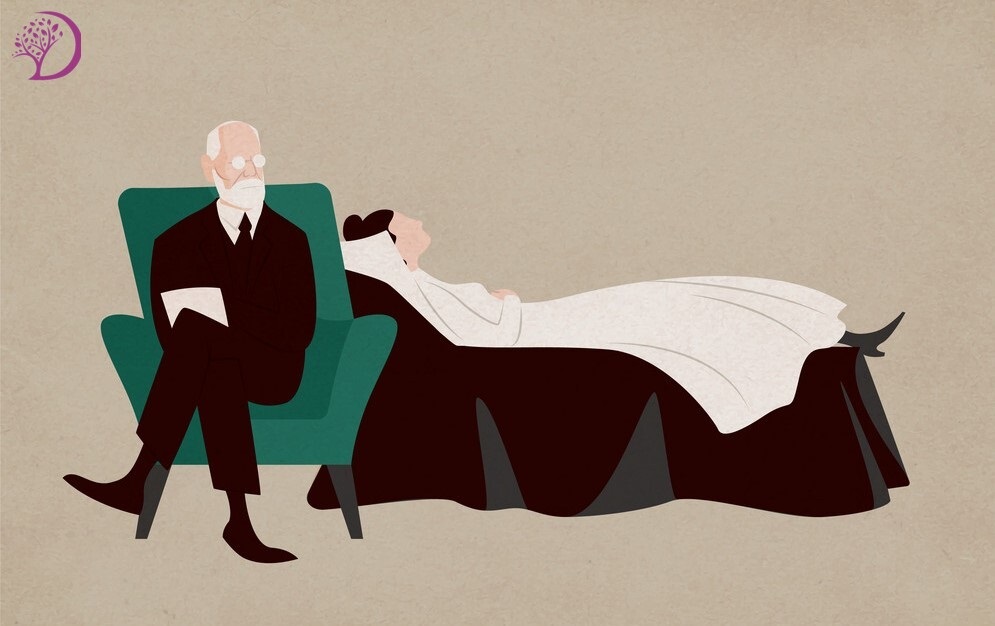Are dreams an interpretation of pent-up desires? Psychoanalytic science believes that dreams, gestures, jokes and revelations carry meanings and connotations that reflect what lies within the soul, and it explains these phenomena as a means of reaching the unconscious worlds within man, where the content of these phenomena is a mirror of the challenges and internal conflicts faced by the individual.
Are dreams an interpretation of pent-up desires?
Psychoanalytic science is a valuable tool for understanding human behavior and revealing the driving factors behind actions and behaviors, thanks to this analysis individuals can discover their behavior patterns and identify weaknesses and strengths in their personalities, enabling them to develop personally and grow mentally.
Interpreting repressed desires within a dream
It is commonly believed that dreams may be the expression of repressed desires or wishes that have not been fulfilled in reality, and some psychological theories such as Freud’s theory suggest that dreams carry hidden meanings that may be related to intangible desires or social constraints that an individual lives.
For example, dreams depicting success, power, or sex may appear as a way of the mind expressing pent-up desires in these areas, and recurring dreams about certain situations or people may appear as an attempt by the mind to address internal conflicts or achieve psychological balance.
However, it cannot be said absolutely that all dreams are the expression of repressed desires, as dreams may also be the result of other factors such as daily experiences, psychological stress, or even interaction with the social environment.
Psychoanalytic science of dreams
At the end of the nineteenth and beginning of the twentieth centuries, a new branch of psychology arose, psychoanalytics, founded by the Austrian thinker Sigmund Freud.
It has been discovered that the human being is not just a feeling but also has an invisible side known as the unconscious, and psychoanalytic science indicates that the initial relationship between the child and the mother plays an important role in the formation of personality, as the relationship of autism with the mother is formed in the early stages of development.
After that, the role of the father enters in the subsequent months, and each stage of growth leaves its effects and leaves its effects as a result of education and social formation, and with the progress of time, the person forgets many experiences of childhood, adolescence and education, which leads to the accumulation of memories in the subconscious, and here comes the role of psychoanalysis, which seeks to treat diseases and psychological and mental disorders, which began in the first decades of the twentieth century.

The relationship of psychoanalysis to dream
The relationship of psychoanalysis to dream is one of the main areas in the study of the unconscious and understanding the depth of the human psyche, psychoanalytics, founded by the Austrian doctor Sigmund Freud, is one of the first sciences that dealt with the study of dream and gave it great importance.
In psychoanalysis, the dream is a window to the unconscious world within man, where Freud considers the dream an “unconscious play” in which man expresses his desires, whims and internal conflicts in indirect ways.
Psychoanalysis of dreams is also a way to understand the human psyche and reveal behavioral patterns and driving factors behind thoughts and feelings, and psychoanalytic scientists analyze the content and details of dreams in search of hidden symbols and connotations that reveal feelings, desires and deep conflicts in the unconscious, and by understanding the meanings of these symbols, the individual can reach a deeper understanding of himself and identify issues that affect his life and behavior.
In general, psychoanalytic science considers dreaming as one of the main means of understanding the human psyche, recognizing indirect aspects of the self, and deep analysis of thoughts and feelings that may be suppressed in the subconscious.
Read more about: The 5 most famous disturbing dreams.
What are the methods of psychoanalysis of dreaming?
Deep psychoanalytic dimensions in humans include two repressed aspects: sexual impulses and unconscious: Psychoanalytic science explores these dimensions through the analysis of lapses, as these lapses carry deep psychological meanings and reveal the psychological context of the individual.
Psychoanalytic science also deciphers and interprets dreams, as dreams are considered the mirror of the unconscious and carry meanings and symbols that express the deep thoughts and feelings of the individual.
In addition, psychoanalysis works to explain any human activity, whether behavioral or otherwise, and reveals the meanings and connotations behind this activity.
It should be noted that psychoanalytic science is not limited to a specific region, but exists globally and has new and advanced currents that keep pace with modern developments in psychological sciences.
How is the interpretation of dreams in psychoanalysis?

The dream expresses unconscious desires that appear during sleep and are translated through the language of images and symbols, the dream is considered as an alternative satisfaction to desires, as it reflects the reality of the hidden desires of the person, hence the interpretation of dreams in popular programs and websites differs from the scientific approach, as they are interpreted in a superficial way without considering the psychological context of the individual, and these interpretations are just estimates that are not based on scientific foundations, while the sincere vision of the psychological state of the individual is the correct measure instead of relying on dreams.
The dream presents internal images that express the psyche of the person in the subconscious, and this is represented in the use of the language of symbols and images that express something different from the other.
For example: the chair in a dream can symbolize the concept of authority or stability, but the exact interpretation depends on the context and personal background of each individual, and similarly the significance of the shoe in the dream can vary from person to person, and depends on the context and personal circumstances.
Although Arab heritage contains some fixed symbols and interpretations of dreams, they cannot be generally relied upon without taking into account the personal and cultural context of each individual.
The line between psychoanalysis, dream interpretation and quackery
There is a dividing line between psychoanalysis and dream interpretation and charlatanry, the majority strongly reject quackery and superstition and believe in science, yet we analyze and understand the psychological interactions and psychological symbols that appear in dreams.
Based on this analysis, we try to develop our understanding of the self and work to improve it, and Shakespeare added in his play “The Storm” that he said: “We are made of the same material from which dreams were made,” which indicates the deep psychological and emotional side of man and the importance of understanding him.
What are the types of psychological suppression?

The founder of psychoanalysis, Dr. Sigmund Freud, came to a conclusion that divides psychological suppression into two types based on the stage that a person reaches, and these types include:
- Basic psychological suppression: In this type, a person hides unwanted feelings and memories before they reach consciousness, which means that he is in a completely unconscious state.
- Correct psychological suppression: This type of suppression occurs when a person perceives repressed feelings and memories, however, clearly tries to transfer them to the subconscious and remove them from consciousness.
What is the mechanism of psychosuppression?
Before going into the details of the mechanism of psychosuppression, it is necessary to understand Freud’s view of the structure of personality in psychoanalysis, as he believed that personality consists of three main parts:
Ego: It is the component that mediates between the requirements of reality and the unconscious and ideal aspects of personality.
Identifier: It is the unconscious aspect that contains the motivations, desires and basic needs that motivate the behavior.
The superego: It is the ideal and moral aspect that includes values and ideas taken from the individual’s society and caregivers, psychological suppression is a defense mechanism, as it prevents the individual from retrieving disturbing thoughts or memories to consciousness, in order to reduce feelings of anxiety.
The unconscious aspect feeds unacceptable thoughts, while the superego tries to impose moral sense on one’s behavior, and the ego in this context seeks to balance different aspects.
Although suppression may initially be effective for calming anxiety, it may eventually lead to increased negative emotions and anxiety in the future, as a result of conflicts between the unconscious and the superego.
Read more about: Interpretation of seeing the sky in a dream.
Are pent-up memories always true?
Despite Dr. Freud’s passion for his theory of psychological suppression, he discovered a problem related to the validity of repressed memories suffered by some patients, as it was later found that many of these memories are inaccurate, and this is proven by Elizabeth Loftus, an American psychologist, who showed that it is possible to implant wrong memories in people, as a result of which many experts in psychology believe that the presence of repressed memories is very rare.
Despite this, psychologists believe that memory suppression occurs rarely, but it is possible that people who experience strong trauma resort to memory suppression to help continue in their daily lives, and on the other hand, trauma may enhance memory to restore painful memories.
Hence, people who tend to suppress feelings and thoughts have difficulties in accurately recalling events, due to their suppression of memories and associated feelings.
Examples to clarify the concept of psychological suppression and its impact on the dream
Here are some examples that illustrate the concept of psychological repression more realistically:
- Being abused by one or both parents or a close person can suppress the painful memories of these conditions, and thus the person becomes an adult without being aware of these memories, these memories can continue to affect a person’s behavior and hinder him in forming healthy relationships.
- An adult’s experience of a spider bite during his childhood may lead to the development of spider phobia without the person remembering this experience as a child, these memories are suppressed in the subconscious, making the person feel afraid of spiders without realizing the real reason behind this fear.
Understand the role of dreams in Freudian theory

Dreams have been the focus of human curiosity since ancient times, interpreting them in multiple ways, ranging from being considered messages from the gods to being considered reflections of our subconscious mind, but Sigmund Freud brought a new perspective to the study of dreams.
He believed that dreams are key to unlocking pent-up memories and desires, and that analyzing them can provide a deep understanding of the human psyche, and in this regard we will explore the role of dreams in Freudian theory and how they can be used to better understand human motivations.
The unconscious mind: At the heart of Freudian theory lies the belief that the unconscious mind plays a prominent role in shaping our behavior and personality, and the unconscious mind, according to Freud, is a reservoir containing our desires, fears and repressed memories that we do not realize, and Freud considers that dreams are the means by which the unconscious mind communicates with the conscious mind, and we can reveal the hidden desires and motives that drive our behavior.
The apparent and latent content of dreams
Freud distinguishes between the apparent content and the latent content of dreams, where the apparent content refers to the superficial and apparent aspects of the dream, while the latent content refers to the hidden and unconscious meaning underlying the dream.
Freud believed that apparent content is a kind of camouflage of latent content, and that by analyzing apparent content we can discover the true meaning and purpose of the dream.
The role of symbols in the interpretation of a dream
Dream interpretation is the process of analyzing a dream to reveal its hidden meaning according to Freud ‘dream interpretation includes free association, where the patient releases everything that comes to his mind when he thinks of a certain symbol or image in the dream, after which the analyst uses this information to reveal the latent content of the dream, as Freud believes that dream interpretation was a vital tool for understanding the unconscious mind and resolving psychological conflicts.
The process of dream interpretation
Dream interpretation represents the process of analyzing a dream in order to reveal its hidden meaning, and according to Freud, dream interpretation includes what is known as free association, where the patient releases everything that comes to his mind when he thinks of a specific symbol or image in the dream.
The analyst then uses this information to reveal the latent content of the dream, and Freud believes that dream interpretation is a vital tool for understanding the unconscious mind and resolving psychological conflicts.
Criticisms of Freud’s theory
Freudian theory faces multiple criticisms from various quarters, with some arguing that Freud’s focus on repressed sexuality and aggression has lost its relevance with the development of time, and that it ignores other important motives, and others argue that Freud’s theory is self-excessively self-evident and lacks empirical evidence to support his claims.
Despite these criticisms, Freudian theory still has a significant impact in the field of psychology, dreams play a crucial role in this theory, as they can provide insight into the unconscious mind, by analyzing the clear and latent content of dreams, as well as the symbols they contain can reach a deeper understanding of our motives and desires.
Despite criticism, Freudian theory still exerts considerable influence in the field of psychology and continues to inspire researchers and practitioners today.
Basics of Dream Analysis
The art of analyzing dreams is the process of interpreting the symbols and images that appear in dreams with the aim of understanding the unconscious mind more deeply, and psychotherapists and psychologists use this tool to help individuals explore their thoughts, feelings and internal behaviors, and dreams are an expression of the depth of the subconscious mind, and through their analysis can reveal hidden meanings and interpret the messages that the mind is trying to convey, this art helps guide individuals to understand themselves more and deeper.
Keep your dream diary
One important aspect of dream analysis is keeping a record of them, which is a recording diary that allows you to document the dreams you remember, you can use this record to identify themes, patterns and recurring symbols in your dreams by recording your dreams regularly, and you can learn how to understand the language of your personal dreams and develop a deeper view of the messages your subconscious mind is trying to communicate.
Select recurring symbols
Symbols form an essential part of dream analysis, as they are representations of ideas or concepts that are often difficult to express in words, by identifying recurring symbols in your dreams, you can get a deeper understanding of your unconscious mind, for example, if you see snakes appear in your dreams regularly, these snakes may represent repressed fears or desires.
Pay attention to emotions
Emotions are an essential part of dream analysis, as they can provide clues about our mental state and the issues we struggle with, by paying attention to the emotions we experience in our dreams, and we can gain a deeper understanding of our unconscious mind, for example: if you dream of feeling anxious or afraid, it may be a sign of stress in our waking life.
When analyzing dreams, the context of a dream is an important element, as the people, places and events in our dreams can provide clues to what is going on in our waking life, and by examining the context of the dream we can gain a deeper understanding of the messages that the subconscious mind is trying to convey. For example, if you dream of getting lost in the forest, it may represent a feeling of loss or uncertainty in your waking life.
Use the dictionary of dreams
Dream dictionaries are an important tool for dream interpretation, providing definitions of common dream symbols and helping to understand the messages inherent in the subconscious mind.
However, we must realize that the meaning of the dream symbol may vary from person to person based on personal background and different experiences, so we must take into account the question of specialized scholars.
We ended up knowing all the psychological details that answer whether dreams are an explanation of repressed desires? Which you have not finished answering, we recommend that you follow us to learn more in-depth information that you will not get tired of.
Discover what your dreams are telling you by reaching out directly to a certified dream interpreter on the Dream app. Download now!





